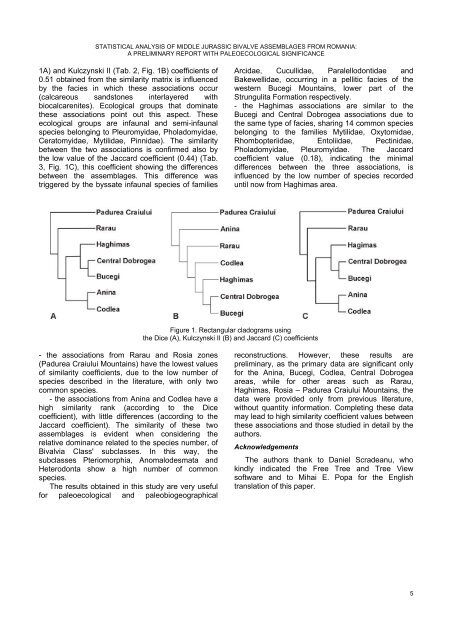statistical analysis of middle jurassic bivalve assemblages from
statistical analysis of middle jurassic bivalve assemblages from
statistical analysis of middle jurassic bivalve assemblages from
You also want an ePaper? Increase the reach of your titles
YUMPU automatically turns print PDFs into web optimized ePapers that Google loves.
STATISTICAL ANALYSIS OF MIDDLE JURASSIC BIVALVE ASSEMBLAGES FROM ROMANIA:<br />
A PRELIMINARY REPORT WITH PALEOECOLOGICAL SIGNIFICANCE<br />
1A) and Kulczynski II (Tab. 2, Fig. 1B) coefficients <strong>of</strong><br />
0.51 obtained <strong>from</strong> the similarity matrix is influenced<br />
by the facies in which these associations occur<br />
(calcareous sandstones interlayered with<br />
biocalcarenites). Ecological groups that dominate<br />
these associations point out this aspect. These<br />
ecological groups are infaunal and semi-infaunal<br />
species belonging to Pleuromyidae, Pholadomyidae,<br />
Ceratomyidae, Mytilidae, Pinnidae). The similarity<br />
between the two associations is confirmed also by<br />
the low value <strong>of</strong> the Jaccard coefficient (0.44) (Tab.<br />
3, Fig. 1C), this coefficient showing the differences<br />
between the <strong>assemblages</strong>. This difference was<br />
triggered by the byssate infaunal species <strong>of</strong> families<br />
Arcidae, Cucullidae, Paralellodontidae and<br />
Bakewellidae, occurring in a pellitic facies <strong>of</strong> the<br />
western Bucegi Mountains, lower part <strong>of</strong> the<br />
Strungulita Formation respectively.<br />
- the Haghimas associations are similar to the<br />
Bucegi and Central Dobrogea associations due to<br />
the same type <strong>of</strong> facies, sharing 14 common species<br />
belonging to the families Mytilidae, Oxytomidae,<br />
Rhombopteriidae, Entoliidae, Pectinidae,<br />
Pholadomyidae, Pleuromyidae. The Jaccard<br />
coefficient value (0.18), indicating the minimal<br />
differences between the three associations, is<br />
influenced by the low number <strong>of</strong> species recorded<br />
until now <strong>from</strong> Haghimas area.<br />
Figure 1. Rectangular cladograms using<br />
the Dice (A), Kulczynski II (B) and Jaccard (C) coefficients<br />
- the associations <strong>from</strong> Rarau and Rosia zones<br />
(Padurea Craiului Mountains) have the lowest values<br />
<strong>of</strong> similarity coefficients, due to the low number <strong>of</strong><br />
species described in the literature, with only two<br />
common species.<br />
- the associations <strong>from</strong> Anina and Codlea have a<br />
high similarity rank (according to the Dice<br />
coefficient), with little differences (according to the<br />
Jaccard coefficient). The similarity <strong>of</strong> these two<br />
<strong>assemblages</strong> is evident when considering the<br />
relative dominance related to the species number, <strong>of</strong><br />
Bivalvia Class' subclasses. In this way, the<br />
subclasses Pteriomorphia, Anomalodesmata and<br />
Heterodonta show a high number <strong>of</strong> common<br />
species.<br />
The results obtained in this study are very useful<br />
for paleoecological and paleobiogeographical<br />
reconstructions. However, these results are<br />
preliminary, as the primary data are significant only<br />
for the Anina, Bucegi, Codlea, Central Dobrogea<br />
areas, while for other areas such as Rarau,<br />
Haghimas, Rosia – Padurea Craiului Mountains, the<br />
data were provided only <strong>from</strong> previous literature,<br />
without quantity information. Completing these data<br />
may lead to high similarity coefficient values between<br />
these associations and those studied in detail by the<br />
authors.<br />
Acknowledgements<br />
The authors thank to Daniel Scradeanu, who<br />
kindly indicated the Free Tree and Tree View<br />
s<strong>of</strong>tware and to Mihai E. Popa for the English<br />
translation <strong>of</strong> this paper.<br />
5
















